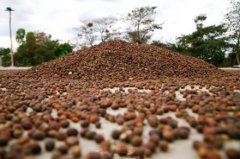The relationship between coffee beans and countries in the producing area of high-quality coffee beans

Mexican of Central America and Mexico
Coffee is mainly concentrated in Chabas, Oaxaca, Veracruz, Puebla, Guerrero, Hidalco, St. Lewis and Porto. The annual output is about 5 million bags, which is the main source of income for agricultural products.
Mexican coffee beans have large particles, and the coffee produced is smooth, mellow and fragrant. Coffee is light in color, high in acidity, mostly grown under natural conditions, without the use of chemical fertilizers and insecticides, coffee is light in color, high in acidity, crisp in taste and refreshing.
Central America Guatemala Guatemala
The fertile volcanic soil breeds a unique flavor of boutique coffee beans Antigua coffee. Its charm lies in its balanced and refreshing fruit acid, rich spice flavor, unique smoky taste, complex and changeable taste, with excellent sour and sweet taste, smooth lubrication, the higher the altitude of the coffee beans, the more mellow the growth. it is the best material for mixed coffee, which is divided into seven grades according to altitude, and the higher the altitude is, the more mellow it is.
Central America Costa Rica Costa Rica
Coffee is the source of Costa Rica's economy in countries that grow coffee and bananas for commercial value. With a population of only 3.5 million, the country has 400m coffee trees, accounting for 25 per cent of total exports.
Costa Rican volcanic soil is very fertile, planting Arabica coffee trees are mostly manual picking, coffee particles are full, ideal acidity, unique and strong aroma. It has always been famous for its balanced, clear and berry-flavored fruit acid. High-quality coffee is called extra hard beans.
South America Brazil Brazil
Brazil is the number one coffee producer and marketer in the world. The annual output exceeds 30 million bags (60 kg / bag), accounting for 31% of the world's coffee exports. Because the picking method is rough, most of them are below 1200 meters above sea level, and there are no trees to shade, mature and immature coffee beans are picked together. Therefore, coffee experts do not think highly of Brazilian coffee and do not meet the conditions of fine coffee beans.
The entrance is sweet and pure, with a thick finish without any thankless acidity and astringency.
Columbia Colombia in South America
In 1808, immigrant Moose introduced coffee to Colombia for the first time from French Anles via Venezuela. Is the world's largest producer of high-quality Arabian washed coffee, with an annual output of 13 million bags (60 kg).
Colombia has superior geographical and climatic conditions, which make the coffee delicious and famous all over the world. Coffee beans are full of grains, rich in nutrition, rich in flavor and moderate in acidity.
African Ethiopian Ethiopia
In the hometown of coffee, the aroma of coffee is neither strong nor irritant. it is produced in Harald, Yega Xuefei, Sidamo, Lim, Gemma, Hawkmputi, Capa and so on. Harald coffee is the representative of Ethiopia, it has a strong Arab flavor, dry aroma slightly sour wine, mellow, with a strong pure texture, and with a wonderful dark chocolate aftertaste.
Africa Kenya Kenya
Located in East Africa, it is one of the top coffee producing countries in the world and the favorite coffee in the industry. It is planted at an altitude of about 1500mi 2000 meters. It is harvested twice a year, divided into PB,AA++,AA+,AA,AB,C,T,TT, with an annual output of about 1.6 million bags (60 kg).
Its particles are symmetrical with slightly fruity and wine aromas, and the taste is perfect and rich.
African Tanzania Tanzania
In the countries that put coffee into the national emblem, the Kilimanjaro region once became one of the most economically powerful regions because of coffee growth. in recent years, due to the deterioration of the coffee industry, the economic situation of coffee in the region has changed.
Tanzanian coffee is crisp, with a taste similar to that of Chinese and American coffee and less acidic than Kenyan coffee.
Asia China China
Coffee is cultivated in Yunnan, Hainan and other places in China. Among them, due to the unique geographical environment and climatic conditions, Yunnan coffee has formed a unique flavor of strong but not bitter, fragrant but not strong, with a little fruit flavor. World-class coffee experts evaluate it as the best coffee in the world, and its cultivation techniques. Per unit yield is also world-class.
Asian Indonesia Indonesia
Java coffee was once synonymous with coffee. Java is the largest island in Indonesia. It is a mixture of mild sour, chocolate, earthy and spicy flavors, mellow, mild acidity and long-lasting fragrance. It is known as a rich licorice flavor. Sumatra, the second largest island, has famous coffee manning and Ancora. Full of particles, full of flesh, heavy taste, high mellow, rich and lively dynamic, smooth taste, in addition, it also has a faint earthy fragrance, which is described as "herbaceous fragrance".
Asia Yemen Yemen
Most of the coffee exported is named after Mocha, the port of Yemen.
Beans are smaller and rounder than other beans, look like peas, have high acidity, and mix with a strange spicy flavor, fine chocolate, high quality and slippery aroma.
Other producing countries Australia Austrlia
It is a pity that only a small number of products enter the export market, because production is subject to high labor costs, people can not use cheap mechanical tools for picking, so they have to rely on manual harvesting. With a touch of natural spices or flowers and fruits, clean, sticky, chocolate candy with obvious sweetness and nutty flavor; as espresso beans, single-serving beans or blending.
Hawaii of Hawaii, other producing countries
Hawaii's unique geographical location and volcanic ash soil make Hawaiian Kona coffee of very high quality.
Important Notice :
前街咖啡 FrontStreet Coffee has moved to new addredd:
FrontStreet Coffee Address: 315,Donghua East Road,GuangZhou
Tel:020 38364473
- Prev

The coffee growing belt lies in the tropics between the Tropic of Cancer and the Tropic of Cancer.
Most of the coffee producing areas in the world are located in the tropics between the Tropic of Cancer and the Tropic of Cancer, which we call the coffee belt and Coffee Belt or Coffee Zone in English. As a tropical cash crop, coffee trees grow in coffee belts with excellent climatic conditions, where the sun shines all the year round, is rich in calories and Rain Water, and the annual average temperature is above 20 ℃. But the high temperature
- Next

The reason why the basic knowledge of coffee affects the taste of coffee
A cup of coffee, from the curl of aroma, extends to a variety of sour, bitter and astringent flavors, and ends with a long aftertaste, the middle taste is very subtle, and there are many reasons for this subtle taste. From a large point of view: among the factors that determine the taste of a cup of coffee: raw bean quality accounts for 60%, roasting accounts for 30%, extraction accounts for 10%. Just as there is no good.
Related
- Beginners will see the "Coffee pull flower" guide!
- What is the difference between ice blog purified milk and ordinary milk coffee?
- Why is the Philippines the largest producer of crops in Liberia?
- For coffee extraction, should the fine powder be retained?
- How does extracted espresso fill pressed powder? How much strength does it take to press the powder?
- How to make jasmine cold extract coffee? Is the jasmine + latte good?
- Will this little toy really make the coffee taste better? How does Lily Drip affect coffee extraction?
- Will the action of slapping the filter cup also affect coffee extraction?
- What's the difference between powder-to-water ratio and powder-to-liquid ratio?
- What is the Ethiopian local species? What does it have to do with Heirloom native species?

